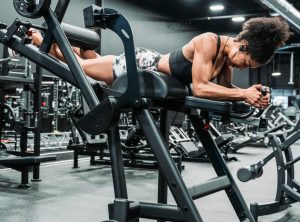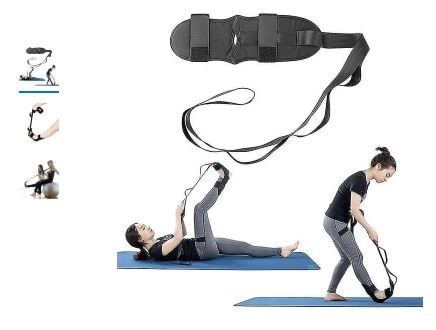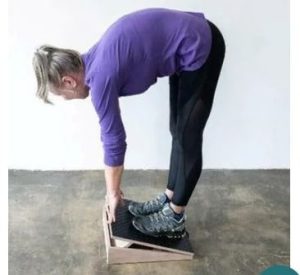To perform a hamstring stretch
Hamstring Stretch Equipment. you typically don’t need any specific equipment. However, there are some pieces of equipment that can enhance your stretching experience and help you achieve a deeper stretch:
Yoga Mat: Provides cushioning and support for your body during the stretch, especially if you’re performing the stretch on a hard surface.
Yoga Strap or Resistance Band: These are excellent tools for increasing flexibility and range of motion. You can loop them around your foot and gently pull towards you to deepen the stretch.
Yoga Blocks: These can be used to support your hands or prop up your hips during certain hamstring stretches, allowing you to maintain proper alignment and posture.
Stretching Bench or Table: If available, these can provide a stable surface for performing hamstring stretches while seated or lying down, offering support and allowing you to focus on the stretch without worrying about balance.
Foam Roller: While primarily used for self-myofascial release, a foam roller can also help in stretching out tight muscles, including the hamstrings. You can use it to roll out any knots or adhesions before or after stretching.
Hamstring Stretch Equipment. Stretching Machine:
These machines are specifically designed to target various muscle groups, including the hamstrings. They typically have adjustable settings to customize the stretch intensity and angle.
Remember, while equipment can be helpful, it’s not necessary for performing a hamstring stretch. You can achieve effective results using just your body weight and a few simple techniques. Always listen to your body and stretch within your comfort level to avoid injury.
To perform a hamstring stretch, you don’t necessarily need specialized equipment, but certain tools can enhance the effectiveness and safety of the stretch. Here’s a list of equipment commonly used for hamstring stretching:
Yoga Mat: Provides a comfortable surface for performing stretches and protects your body from hard floors.
Stretch Strap or Yoga Strap: This is a long, flexible strap with loops or handles at each end. It helps you maintain proper alignment and gradually increase the stretch by extending your reach. You can also use a towel or belt if you don’t have a strap.
Stretching Bench or Slant Board
Hamstring Stretch Equipment. These are angled platforms designed to support your back and provide a stable surface for stretching. They allow you to adjust the angle of the stretch to target different areas of the hamstring.
Foam Roller: While primarily used for self-myofascial release (SMR), a foam roller can also assist in hamstring stretching. By rolling the backs of your thighs over the foam roller, you can release tension and improve flexibility.
Stretching Machine: There are various types of stretching machines available, such as seated or standing hamstring stretchers. These machines provide controlled and adjustable stretching for the hamstrings.
Balance Ball: Using a balance ball can add an element of instability, engaging more muscles while stretching the hamstrings. You can perform seated or lying hamstring stretches with the support of a balance ball.
Wall or Door Frame: Utilizing a wall or a door frame can aid in passive hamstring stretches. Lie on your back and extend your leg upward, resting your heel against the wall or the door frame while keeping your other leg bent.
Step Platform or Stair:
You can use a step platform or a stair to perform standing hamstring stretches. Simply place one foot on the platform at a comfortable height and lean forward from your hips until you feel a stretch in your hamstring.
Resistance Bands: These elastic bands can be anchored to a stable object and looped around your foot to add resistance to your hamstring stretches, allowing for a deeper stretch.
Chair or Bench: These can be used to support your body during seated hamstring stretches. Sit on the edge of a chair or bench with one leg extended and the other foot flat on the ground, then lean forward to stretch the hamstring of the extended leg.
Remember to warm up before stretching and perform each stretch slowly and gently, avoiding bouncing or jerking movements to prevent injury. If you’re unsure about using any equipment or performing specific stretches, it’s best to consult with a qualified fitness professional or physical therapist.
For a full hamstring stretch, you don’t necessarily need specialized equipment, but certain tools can enhance the effectiveness of your stretch and provide support. Here’s a list of equipment commonly used for hamstring stretches:
Yoga Mat: Provides a comfortable surface for stretching and prevents slipping.

Stretch Strap or Yoga Belt: Helps in deepening the stretch by extending your reach. You can loop it around your foot to pull it closer towards your body while keeping your leg straight.
Foam Roller: Not only for hamstrings but for the whole body. It’s useful for self-myofascial release, which can improve flexibility and reduce muscle tightness. Hamstring Stretch Equipment.
Yoga Blocks: These can be used to support your hands or prop up your hips during certain hamstring stretches, allowing you to maintain proper alignment and gradually deepen the stretch.
Exercise Ball: It can be used to perform hamstring curls, which strengthen the muscles while also improving flexibility.
Resistance Bands: These can be attached to stable furniture or a doorframe to assist in stretching. Loop the band around your foot and gently pull towards your torso for a deep hamstring stretch.
Leg Stretching Machine: If you have access to a gym, you might find a leg stretching machine helpful. It allows you to sit and adjust the angle of your stretch comfortably.
TRX Suspension Trainer:
This versatile piece of equipment can be used for various exercises, including hamstring stretches. You can adjust the straps to find the right angle and intensity for your stretch.
Ankle Weights: These can be worn while performing hamstring stretches to add resistance and increase the intensity of the stretch.
Pilates Reformer: Typically found in Pilates studios, the reformer can be used for dynamic hamstring stretches, combining strength and flexibility exercises.
Remember, it’s crucial to warm up your muscles before stretching, especially for deeper stretches like hamstring stretches. And always listen to your body – never force a stretch beyond your comfort level to avoid injury.



